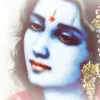Originally posted by: metacrisis
This route of the story would've definitely been fascinating to read! In this version, Krishna probably wouldn't drift away from Nand-Yashoda as seen in most popular retellings (although, I guess some scriptures do make them reunite later-ish?).
This hand-holding iconography has a nice callback value to Puri-Jagannath idols. Also, I read that some traditions identify (Nap)Pinnai with Radha, so maybe that might be a contributing factor to the lover/sister confusion?
Here, I am just going on Pinnai/Nappinnai name similarity, I don't actually know Tamil well enough to decide if this counts.
In Indian traditions also do we count tithi by midnight?
Kamsa just keeps getting worse with each new story I hear, the guy clearly needs to chill out a bit.
However, in this version, Satyabhama would be his aunt right? I would say that's icky, but Krishna clearly has a history with aunties, throughout folklore.
Bhāgavata-purāṇa narrates that on the occasion of a solar eclipse, the Yādavas went to Prabhāsa and the gopas also happened to be there.
I think that the Jagannātha-Purī triad is Ekānaṃśā between her brothers.
Lover imagery for Piṉṉai in Cilappadhikāram and Nappiṉṉai in Maṇimekhalai is much older than the Rādhā tradition. Poetic and devotional traditions have given Kṛṣṇa several girlfriends: Kubjā (Trivakrā), Nīlā, Pālī, Dhanyā, Cārukeśī, Candrāvalī, Lalitā ... In one verse, Kṛṣṇa says, "How are you, Rādhā?" to Pālī, and she retorts, "How are you, Kaṃsa?" "Where do you see Kaṃsa?" "Well, where do you see Rādhā?" In another verse, Rādhā accuses Kṛṣṇa of kissing Cārukeśī and he pretends not to know anyone by that name.
Tithi can change at any time of day.
In stories where Satyabhāmā is Kaṃsa's sister, Kaṃsa is not related to Devakī.

























